When it comes to fruits, we often think of vibrant colors like the red of strawberries or the orange of oranges. But did you know that there are fruits with white and black seeds that offer a unique twist on the traditional fruit experience?
One such fruit is dragon fruit, also known as pitaya or pitahaya. This brightly colored fruit is grown in Asia, Mexico, Central America, and South America and belongs to the cactus family. Dragon fruit comes in different varieties, each with its own characteristics in terms of skin color, flesh color, and seed color. Some varieties have white flesh and black seeds, adding a visually striking element to this already stunning fruit.
Dragon fruit is not the only fruit with white and black seeds. Another fruit that shares this characteristic is kadushi, also known as Peruvian apple cactus. This tall, columnar cactus is native to South America and produces fruit with a red, inedible skin and white flesh speckled with black seeds.
Key Takeaways:
- Dragon fruit is a brightly colored fruit with white or red flesh and black seeds.
- Kadushi fruit is a lesser-known fruit with white flesh and black seeds.
- Both dragon fruit and kadushi fruit belong to the cactus family.
- Dragon fruit is grown in various regions around the world, while kadushi fruit is native to South America.
- These fruits with white and black seeds offer a unique visual appeal and can be enjoyed in various culinary creations.
Nutritional Benefits of Dragon Fruit
Dragon fruit, with its vibrant colors and unique appearance, not only adds beauty to your plate but also provides numerous nutritional benefits. This exotic fruit, rich in essential vitamins and minerals, is a powerhouse of nutrients. Let’s explore the nutritional information of dragon fruit and discover why it’s a valuable addition to a healthy diet.
“Dragon fruit is nature’s gift – a delicious and nutritious fruit with remarkable health benefits.”
Fiber-Rich and Low-Calorie
Dragon fruit is low in calories and high in dietary fiber, making it a smart choice for those watching their weight. A 100-gram serving of dragon fruit contains only 60-80 calories and provides around 1.5-2 grams of fiber, aiding in healthy digestion and promoting a feeling of fullness.
Antioxidant Powerhouse
Rich in antioxidants, dragon fruit helps protect your body against harmful free radicals. These antioxidants help reduce inflammation, boost the immune system, and lower the risk of chronic diseases. Vitamin C, present in abundance in dragon fruit, contributes to a stronger immune system and protects the body’s cells from oxidative stress.
Heart-Healthy Properties
The nutritional benefits of dragon fruit extend to cardiovascular health as well. The fruit’s high fiber content assists in lowering cholesterol levels, maintaining a healthy heart. Additionally, dragon fruit’s magnesium and calcium content plays a crucial role in promoting healthy blood flow and maintaining optimal heart function.
Iron-Rich Fruit
Dragon fruit is a good source of iron, a mineral essential for the production of red blood cells and the transportation of oxygen throughout the body. Including dragon fruit in your diet can help prevent iron deficiency and combat symptoms such as fatigue and weakness.
Discover the nutritional power of dragon fruit and enjoy its delicious flavors while supporting your overall health and well-being.
| Nutrient | Amount per 100g |
|---|---|
| Calories | 60-80 |
| Fiber | 1.5-2g |
| Vitamin C | 20-30mg |
| Magnesium | 15-20mg |
| Calcium | 8-10mg |
| Iron | 0.5-0.7mg |
Discover the nutritional power of dragon fruit and enjoy its delicious flavors while supporting your overall health and well-being.
Taste and Culinary Uses of Dragon Fruit
Dragon fruit is a tropical fruit that offers a unique and delightful taste. When you take a bite, you’ll experience a burst of sweetness that is often compared to a combination of kiwi and pear flavors. The texture of dragon fruit is crunchy, similar to a crisp apple, making it a refreshing fruit to eat.
Dragon fruit is extremely versatile in the culinary world and can be used in a variety of dishes. Here are some wonderful ways to enjoy dragon fruit:
- On its own: To enjoy the pure taste of dragon fruit, simply cut it in half or quarters, peel off the skin, and scoop out the juicy flesh. It’s a perfect snack for a hot summer day.
- Fruit salads: Dragon fruit adds a pop of color and flavor to fruit salads. Cut it into bite-sized pieces and mix it with your favorite fruits for a refreshing and visually appealing salad.
- Smoothies: Blend dragon fruit with other tropical fruits, such as pineapple and mango, for a delicious and nutritious smoothie. You can also add some coconut water or yogurt for extra creaminess.
- Desserts: Dragon fruit makes a beautiful and healthy topping for desserts. You can use it to decorate cakes, tarts, or even make a dragon fruit salsa to serve with ice cream.
The vibrant color and mild flavor of dragon fruit make it an excellent addition to both sweet and savory dishes. Get creative in the kitchen and experiment with different recipes to fully enjoy the culinary potential of this unique fruit.
“Dragon fruit adds a vibrant and tropical touch to any dish. Its sweet flavor and crunchy texture make it a versatile ingredient that can be used in both sweet and savory recipes.” – Chef Anna Thompson
So don’t hesitate to incorporate dragon fruit into your culinary adventures. It’s not only visually appealing but also packed with essential nutrients that will nourish your body and tantalize your taste buds.
| Dragon Fruit Recipes |
|---|
| Dragon Fruit Smoothie Bowl |
| Dragon Fruit Salsa |
| Dragon Fruit Salad with Honey Lime Dressing |
| Dragon Fruit Popsicles |
Growing and Harvesting Dragon Fruit
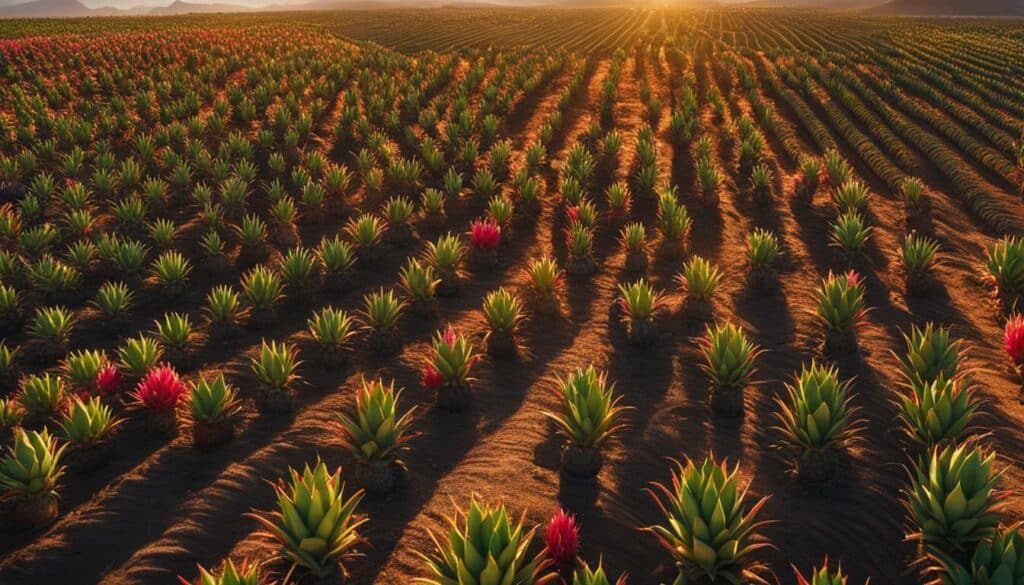
Dragon fruit, scientifically known as Hylocereus, is primarily cultivated in Asia, Mexico, Central America, and South America. It is a fast-growing crop that can bear fruit for more than 20 years once it is established. To successfully grow dragon fruit, follow these essential cultivation steps:
- Choose a sunny location: Dragon fruit plants require full sun exposure to thrive. Select a spot in your garden that receives at least six hours of direct sunlight each day.
- Prepare the soil: Dragon fruit plants prefer well-drained soil. Ensure that the soil is loose, sandy, and slightly acidic, with a pH level between 6 and 7. If the soil in your area is heavy or clay-like, consider adding organic matter or sand to improve drainage.
- Planting the cuttings: Dragon fruit plants are typically propagated from cuttings. Plant the cuttings in the prepared soil, burying them partially to provide stability. Leave the upper portion of the cutting exposed, with at least one or two segments above the soil surface.
- Support the plants: Dragon fruit plants are climbing cacti and require support as they grow. Provide a trellis or sturdy structure for the plants to climb on. This will ensure proper growth and development.
- Watering and fertilizing: Dragon fruit plants have minimal water requirements. Water them moderately, allowing the soil to dry out between watering sessions. Avoid overwatering, as it can lead to root rot. Apply a well-balanced fertilizer during the growing season to promote healthy growth.
- Pollination: Dragon fruit flowers open at night and are typically pollinated by moths and bats. If these pollinators are not present in your area, you may need to hand-pollinate the flowers using a small brush or cotton swab.
- Harvesting: Dragon fruit is ready to harvest when it reaches its full color and gives slightly when gently squeezed. The fruit should be harvested carefully to avoid damaging the delicate skin. After harvesting, store the fruit in the refrigerator and consume it within a week to enjoy its fresh and delicious taste.
Other Fruits with White and Black Seeds
Dragon fruit is not the only fruit with white and black seeds. Another fruit that shares this characteristic is kadushi, also known as Peruvian apple cactus. Kadushi is a tall, columnar cactus native to South America. Its fruit has a red, inedible skin and white flesh speckled with black seeds. The taste of kadushi fruit is often described as a combination of sweetened shaved ice, watermelon, and kiwifruit. Kadushi plants require full sun and can produce multiple crops per year. They are hardy to low temperatures and have the potential to be cultivated in frost-prone areas.
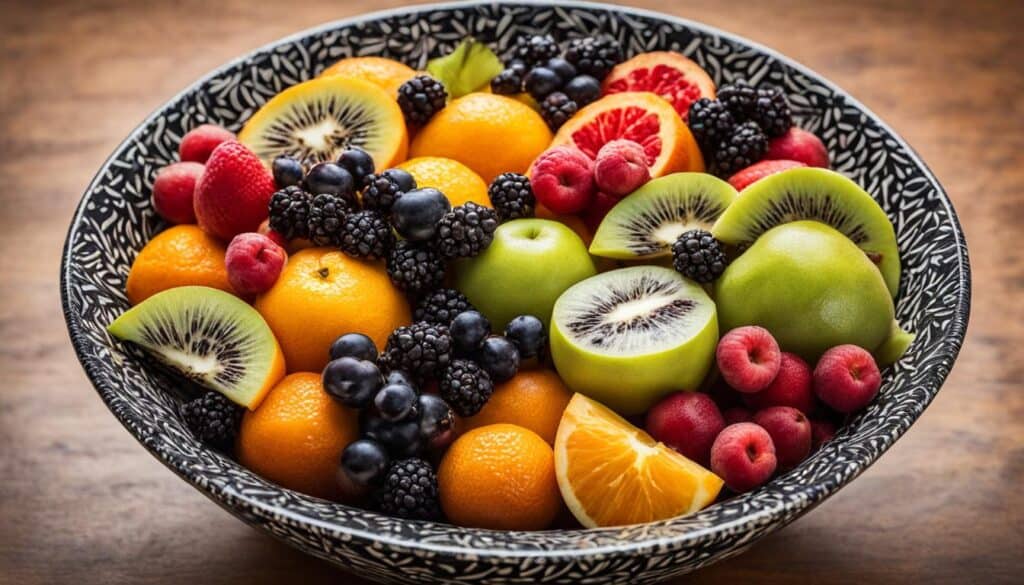
If we compare dragon fruit and kadushi fruit, we can see that both fruits exhibit unique characteristics and offer different flavor experiences. While dragon fruit is known for its vibrant colors and mild sweetness, kadushi fruit stands out with its refreshing, tropical taste. The white flesh and black seeds of both fruits provide an interesting visual contrast in addition to their distinct flavor profiles.
“Kadushi fruit has a unique flavor that combines the refreshing qualities of shaved ice, the sweetness of watermelon, and the tanginess of kiwifruit.”
Just like dragon fruit, kadushi fruit can be enjoyed fresh or incorporated into various dishes and recipes. Its versatility allows it to be used in smoothies, salads, and desserts, adding a refreshing twist to culinary creations. Despite being relatively less known compared to dragon fruit, kadushi has the potential to become a commercially viable fruit crop thanks to its unique qualities and flavor.
Unique Qualities of Kadushi Fruit
When it comes to unique fruits with white and black seeds, kadushi fruit stands out with its distinctive characteristics and advantages over dragon fruit. Let’s explore what makes kadushi fruit so special:
Lower in Calories, Higher in Essential Nutrients
Compared to dragon fruit, kadushi fruit is lower in calories while offering a rich array of essential vitamins and minerals. It is a great source of vitamin C, vitamin B, fiber, and antioxidants, providing numerous health benefits for those who enjoy it.
Free-Standing Cactus with Cold Tolerance
Unlike dragon fruit, which requires trellising for support, kadushi is a free-standing cactus that doesn’t need any additional structure. This makes it easier to grow and cultivate, especially in frost-prone areas where dragon fruit may struggle to thrive. Kadushi’s cold tolerance opens up new possibilities for cultivation in different climates.
Superior Flavor Profiles
Some forms of kadushi fruit are known to have better flavor than certain forms of dragon fruit. Described as a delightful blend of sweetened shaved ice, watermelon, and kiwifruit, kadushi offers a unique taste experience that sets it apart from other fruits.
Drawback: Fruit Splitting
However, it’s important to note that kadushi fruit is prone to fruit splitting, which can be a drawback for commercial cultivation. This means that during the growth and ripening process, the fruit may split open, making it less visually appealing and potentially more challenging to package and transport.
Despite this drawback, the unique qualities of kadushi fruit, ranging from its nutritional profile to its flavor and cold tolerance, make it a compelling fruit to explore and consider adding to your diet.
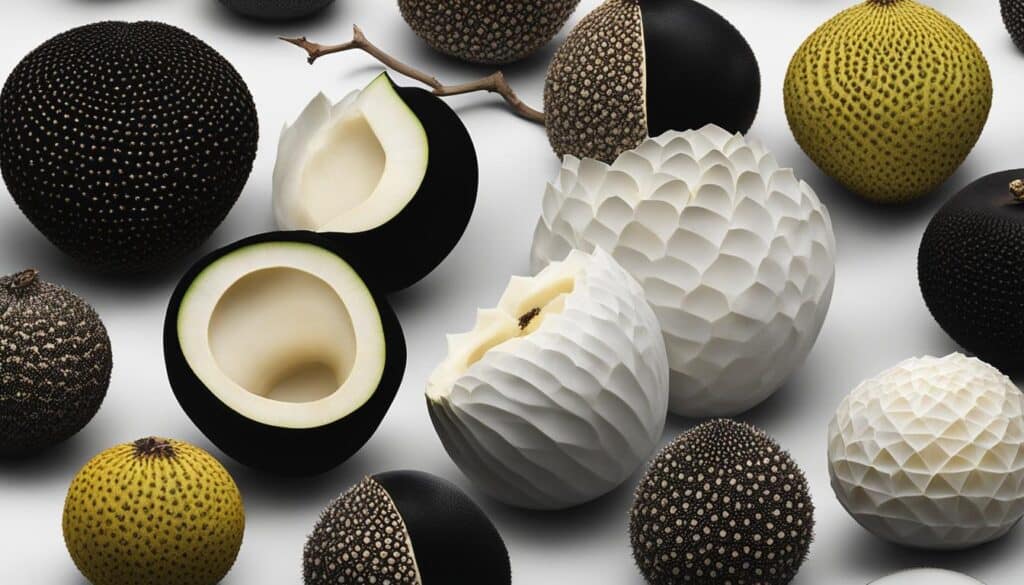
Stay tuned as we dive into the cultivation and harvesting methods of kadushi fruit, as well as its commercial potential and culinary uses.
Cultivation and Harvesting of Kadushi Fruit
When it comes to growing kadushi fruit, proper cultivation techniques are essential for optimal growth and fruitful harvests. Native to South America, kadushi plants thrive in regions with full sun exposure and can tolerate low temperatures. These hardy plants produce large, white, round blooms that open at night and close shortly after dawn, attracting pollinators to aid in fruit production.
The development of kadushi fruits takes approximately 60-90 days, with multiple flushes of flowering and fruiting occurring throughout the year. It’s important to monitor the ripening process, as kadushi fruits should be harvested when they are fully colored and slightly soft to the touch. The ripe fruits feature a vibrant red, leathery skin, enclosing white flesh speckled with black seeds.
To ensure a successful harvest, it’s crucial to handle the fruits with care to avoid any damage. Once harvested, they should be stored in a cool, dry place and consumed within a reasonable timeframe to fully enjoy their unique flavor and nutritional benefits.
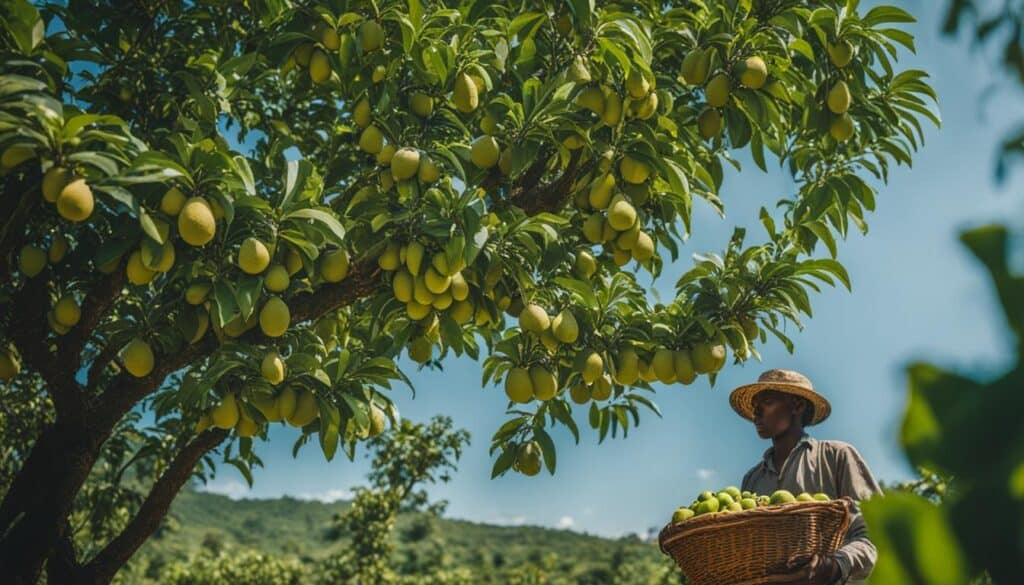
Cultivation Tips for Kadushi Fruit
- Provide full sun exposure for optimal growth and fruit production.
- Choose well-drained soil to avoid waterlogging.
- Monitor temperature requirements, as kadushi plants are tolerant of low temperatures.
- Water the plants regularly, allowing the soil to dry out between waterings.
- Prune the plants to promote proper airflow and prevent overcrowding.
- Use organic fertilizers to nourish the plants and enhance fruit development.
Harvesting Kadushi Fruit
Harvesting kadushi fruit requires careful observation of ripeness indicators. Once the fruits have reached their full color and are slightly soft to the touch, they are ready for harvest. Gently twist the fruit from the stem or use a pair of pruning shears to cut it off. Avoid applying excessive pressure, as kadushi fruits are delicate and can bruise easily.
| Harvesting Steps | Tips |
|---|---|
| Observe fruit color and texture. | Look for vibrant red skin and slightly soft flesh. |
| Twist or cut the fruit from the stem. | Handle the fruits gently to prevent damage. |
| Store the harvested fruit properly. | Keep the fruits in a cool, dry place to maintain freshness. |
Commercial Potential and Culinary Uses of Kadushi Fruit
Kadushi fruit has immense commercial potential as a widely grown fruit crop. With its unique flavor and visual appeal, it has become a sought-after ingredient in various culinary creations.
When it comes to enjoying kadushi fruit, there are several options. You can savor its refreshing taste by simply cutting it open and scooping out the juicy flesh. If you’re feeling adventurous, you can incorporate kadushi fruit into your favorite smoothie recipes to add a tropical twist. It also makes a delightful addition to fruit salads, offering a burst of flavor and texture. For those with a sweet tooth, kadushi fruit can be used in desserts like puddings, tarts, or even as a topping for ice cream.
One of the appealing qualities of kadushi fruit is the pleasant crunchiness added by its black seeds. This unique characteristic contributes to its overall eating experience, enhancing both the taste and texture of dishes.
Although kadushi fruit is prone to splitting, some cultivars have been developed to overcome this issue and produce fruits suitable for commercial sale. This opens up new possibilities for expanding the commercial cultivation of kadushi fruit and making it more readily available in the market.
With its commercial potential and versatility in culinary applications, kadushi fruit is poised to make its mark in the fruit industry. Its unique flavor profile and striking visual appeal offer exciting opportunities for chefs, home cooks, and fruit enthusiasts to explore and experiment with new recipes and creations.
Precautions and Side Effects of Dragon Fruit and Kadushi Fruit
While dragon fruit and kadushi fruit are generally safe for consumption, it is important to be aware of a few precautions and potential side effects.
Allergic Reactions to Dragon Fruit
Some individuals may be allergic to dragon fruit. Allergies can manifest as skin rashes, itching, or digestive discomfort such as nausea or stomach cramps. If you experience any of these symptoms after consuming dragon fruit, it is advisable to discontinue consumption and seek medical advice.
High Fiber Content and Digestive Issues
Both dragon fruit and kadushi fruit are rich in fiber, which is beneficial for digestion. However, consuming excessive amounts of fiber can lead to stomach discomfort, bloating, or diarrhea in some individuals. It is important to listen to your body and consume these fruits in moderation to avoid any digestive issues.
Oxalates in Kadushi Fruit
Kadushi fruit contains oxalates, which are natural compounds found in many fruits and vegetables. While oxalates are generally harmless for most people, they can be potentially harmful to individuals with kidney issues. If you have a history of kidney problems, it is recommended to consult a doctor before incorporating kadushi fruit into your diet.
It is always wise to consult a healthcare professional before making any significant changes to your diet, especially if you have any underlying health conditions or concerns.
Remember to listen to your body, consume these fruits in moderation, and seek medical advice if you experience any adverse reactions.
Conclusion
Fruits with white and black seeds, such as dragon fruit and kadushi fruit, offer a delightful combination of flavors, along with numerous nutritional benefits and culinary possibilities. These fruits are not only visually appealing but also low in calories and high in fiber, making them an excellent addition to a healthy diet.
Dragon fruit, with its vivid appearance, is widely cultivated in various regions around the world. Kadushi fruit, on the other hand, is a lesser-known gem that presents potential for commercial cultivation. Both fruits can be enjoyed fresh or incorporated into an array of delicious dishes and recipes.
It is important to note that while these fruits provide numerous health benefits, it is essential to consume them in moderation and be aware of any potential allergies or side effects. As with any food, it is always a good idea to consult with a healthcare professional if you have any underlying health conditions.
Overall, fruits with white and black seeds not only captivate us with their striking appearance but also offer a burst of nutrition and culinary creativity. Whether you choose dragon fruit or kadushi fruit, be sure to savor their unique flavors and colors.
FAQ
What is dragon fruit?
Dragon fruit, also known as pitaya or pitahaya, is a brightly colored fruit with white or red flesh and black seeds. It belongs to the cactus family and is grown primarily in Asia, Mexico, Central America, and South America.
What are the nutritional benefits of dragon fruit?
Dragon fruit is low in calories and high in fiber, calcium, magnesium, vitamin C, and iron. It promotes healthy digestion, boosts the immune system, reduces inflammation, improves cardiovascular health, and aids in weight management.
How does dragon fruit taste and how can it be used in cooking?
Dragon fruit has a sweet taste that is often compared to a combination of kiwi and pear. It has a crunchy texture and is refreshing to eat. Dragon fruit can be enjoyed on its own or added to fruit salads, smoothies, or used as a topping for desserts.
How do you grow and harvest dragon fruit?
Dragon fruit plants require well-drained soil and full sun for optimal growth. They produce large, showy flowers that open at night and are pollinated by moths and bats. The fruit is ready to harvest when it reaches its full color and gives slightly when gently squeezed.
Are there any other fruits with white and black seeds?
Yes, another fruit with white and black seeds is kadushi, also known as Peruvian apple cactus. It is a tall, columnar cactus native to South America that produces fruit with a red, inedible skin and white flesh speckled with black seeds.
What are the unique qualities of kadushi fruit?
Kadushi fruit has a unique flavor often described as a combination of sweetened shaved ice, watermelon, and kiwifruit. It is lower in calories and higher in essential vitamins and minerals compared to dragon fruit. Kadushi is also more cold tolerant and can be cultivated in frost-prone areas.
How do you cultivate and harvest kadushi fruit?
Kadushi plants require full sun and can tolerate low temperatures. They produce large, white, round blooms that open at night. The fruits take around 60-90 days to develop and ripen. They should be harvested when fully colored and slightly soft to the touch.
What is the commercial potential and culinary uses of kadushi fruit?
Kadushi fruit has the potential to be commercially grown and used in various culinary creations. It can be enjoyed fresh, used in smoothies, salads, and desserts, and offers a refreshing taste and a pleasant crunch from its black seeds.
Are there any precautions and side effects of dragon fruit and kadushi fruit?
Some individuals may be allergic to dragon fruit and may experience skin rashes or digestive discomfort. Both fruits have a high fiber content, which can cause stomach discomfort or diarrhea in some individuals if consumed in excessive amounts. Kadushi fruit contains oxalates, which can be harmful to individuals with kidney issues.
What are the concluding remarks about fruits with white and black seeds?
Fruits with white and black seeds, such as dragon fruit and kadushi fruit, offer unique flavors, nutritional benefits, and culinary versatility. They can be enjoyed fresh or incorporated into various dishes and recipes. However, it is important to be aware of any potential allergies or side effects and to consume these fruits in moderation.
Source Links
- https://www.everydayhealth.com/diet-nutrition/diet/dragon-fruit-how-eat-benefits-taste-more/
- https://floridafruitgeek.com/2020/09/30/experimenting-with-kadushi-cereus-repandus-as-a-fruit-crop/
- https://www.businessinsider.in/science/health/food/dragon-fruit-checkout-its-nutritional-value-health-benefits-and-types-of-dragon-fruit/articleshow/104514471.cms

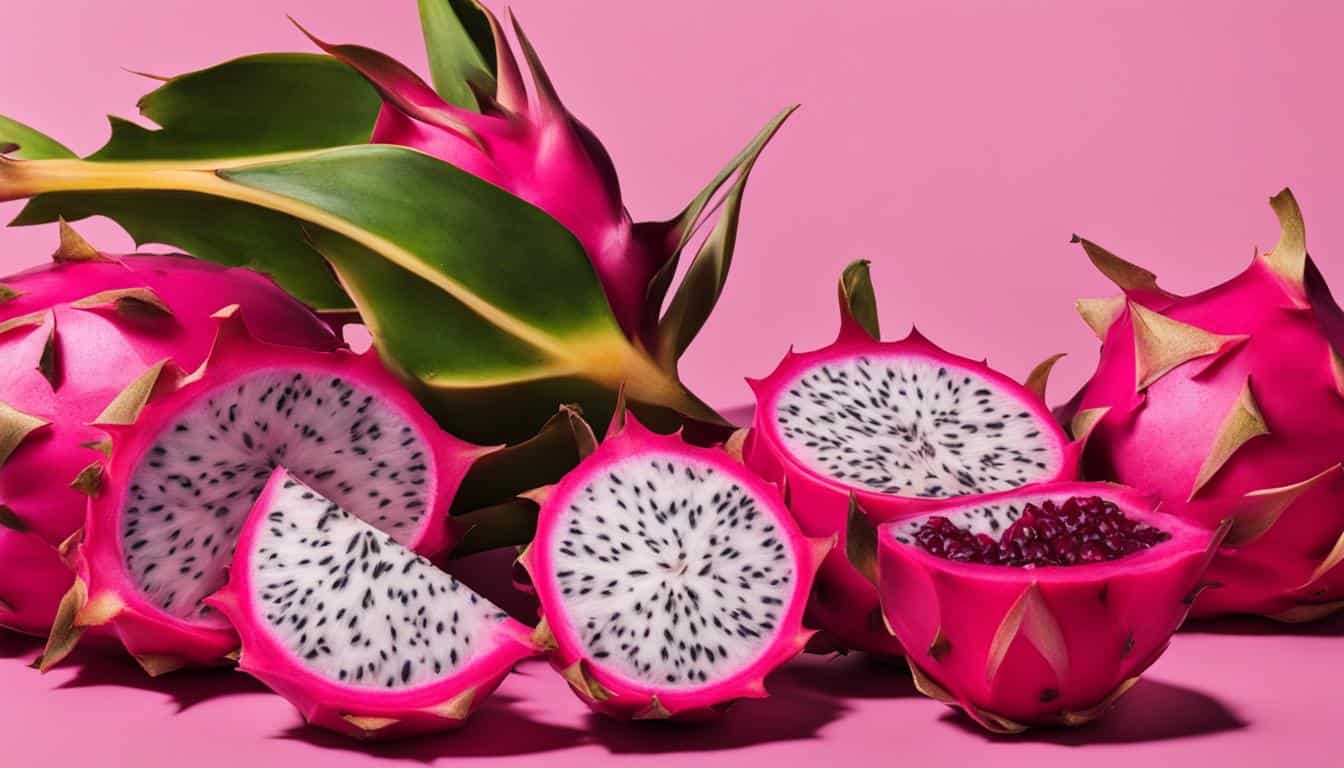



Leave a Reply